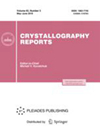投稿信息
稿件收录要求
Crystallography Reports is a journal that publishes original articles short communications, and reviews on various aspects of crystallography: diffraction and scattering of X-rays, electrons, and neutrons, determination of crystal structure of inorganic and organic substances, including proteins and other biological substances; UV-VIS and IR spectroscopy; growth, imperfect structure and physical properties of crystals; thin films, liquid crystals, nanomaterials, partially disordered systems, and the methods of studies.
PEER REVIEW
Crystallography Reports is a peer reviewed journal. We use a single blind peer review format. Our team of reviewers includes over 20 reviewers, both internal and external (95%). The average period from submission to first decision in 2017 was 20 days, and that from first decision to acceptance was 30 days. The rejection rate for submitted manuscripts in 2017 was 20%. The final decision on the acceptance of an article for publication is made by the Editorial Board.
Any invited reviewer who feels unqualified or unable to review the manuscript due to the conflict of interests should promptly notify the editors and decline the invitation. Reviewers should formulate their statements clearly in a sound and reasoned way so that authors can use reviewer’s arguments to improve the manuscript. Personal criticism of the authors must be avoided. Reviewers should indicate in a review (i) any relevant published work that has not been cited by the authors, (ii) anything that has been reported in previous publications and not given appropriate reference or citation, (ii) any substantial similarity or overlap with any other manuscript (published or unpublished) of which they have personal knowledge.




